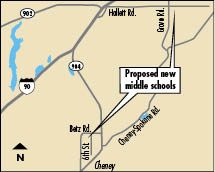
Home » $97 million in Cheney work eyed
$97 million in Cheney work eyed
School district there to seek bonds to build three schools

November 25, 2009
The Cheney School District plans to seek approval of a bond measure that would help pay for $97 million worth of new construction in the district beginning in 2011.
Larry Keller, the district's superintendent, says that three new school buildings—including a new elementary school, a new middle school, and a replacement for an aging and overcrowded middle school—are needed because, in short, "There's no more room at the inn," in the Cheney School District.
"We've been growing between 100 and 125 students per year for the last three or four years," Keller says. The district predicts that it will get another 1,600 to 2,000 children as homes are built on the between 4,000 and 5,000 lots already platted within the 380 square miles of the West Plains the district serves.
That projected growth, he says, makes it clear the district will have to invest in another middle school and another elementary school. Currently, the district has about 3,800 students, Keller says.
In addition to growth needs, Cheney's current middle school needs to be upgraded or replaced, he says.
After a facilities study and survey completed this year, the district determined that modernizing its current middle school building would cost almost as much as the $37 million anticipated cost of replacing it. The current middle school building already is overfilled, with 900 students attending classes in a building designed to accommodate 700 students, Keller says.
A facility planning committee convened by the district has recommended that it replace that middle school, build a second middle school on the east side of the district to accommodate the growing populations of the West Plains, construct an additional elementary school also toward the eastern part of the district, and add on to its Cheney High School. The district has four elementary schools now.
The district plans to ask voters to approve a $79 million bond issue to help pay for the projects, and hopes to secure another $18 million to $20 million in state matching funds that should be available for the middle-school replacement and new elementary school, Keller says.
Also, he says, the district anticipates being able to get good values in construction costs by building soon, and that any savings it could get from the estimated cost of about $37 million per middle school and $22 million for the new elementary school could be used to do some work at the high school.
"There's never been a better time to build than right now because construction and material costs are low," Keller says.
He says construction of the projects would go on for between three and seven years, bringing work to the West Plains.
He says he's hopeful that the bond issue, which would go on the Feb. 10 ballot, would be successful because it would take effect as some other capital levies within the district expire, keeping the tax rate about the same as it is currently. With anticipated additional West Plains commercial development, the district believes the rate would go down for residential property owners over time, he says.
"Our plans have been well thought out. We've worked hard to drive the cost of this down," and to avoid raising the tax rates of property owners in the district.
The replacement middle school would be built on the same property as the current middle school, at 2716 N. Sixth, in Cheney, which Keller says is large enough so the current school could remain open there while the replacement building is constructed on part of the property.
At the same time, construction would begin on a second middle school building, on 40 acres of property the district owns across the street from the Windsor Crossing housing development, southeast of Interstate 90 at 5504 W. Hallett Road. Those schools would be targeted to open in 2012, Keller says. Following construction of the replacement middle school, the current middle school would have to be torn down or sold to a noneducational entity to satisfy state requirements for the matching funds.
Each of the new middle schools would be built to accommodate 750 students, and the elementary school would handle about 400 students, Keller says.
Though the new elementary school also would be located to the east of Cheney, a site hasn't been selected for it yet, he says. That school would be targeted for completion in 2013. Currently, while the board moves forward with its bond issue, the district is seeking qualifications for architectural engineering and design services, and would begin project design soon after the February election, provided the bond measure passes.
"The growth piece is driving us to move out on this at a pretty quick pace," Keller says.
Latest News
Related Articles


_web.jpg?1732178234)

